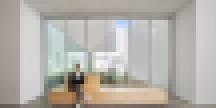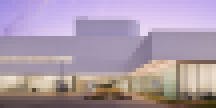As designers drew up plans to revitalize the visual arts complex at California State University, Fullerton, they hoped to create a space that would encourage students to stay on campus as much as possible.
Many of Fullerton’s students commute to campus from home. That means they need comfortable places to do homework, meet with professors or talk to classmates. If not, they run the risk of returning home and skipping class or missing out on academic help.
The new visual arts complex, which cost the university around $65 million, includes two brand new buildings as well as two other renovated spaces. Aside from creating modern facilities that allow students to focus on careers in animation, game art or graphic design, designers thought about college students’ basic necessities: access to WiFi; a place to set their computer; adequate shade from the California sun; even comfortable seating.
Ideally, if students feel at ease staying on campus throughout the day, they’ll also want to be at Fullerton for the long term too, says Christina Delgado, the project manager for Fullerton’s visual arts complex.
As colleges look for ways to engage and retain students, especially as enrollment numbers continue to drop, they’re placing new emphasis on campus design, says Delgado, who is also the arts, community, and education practice group leader at HGA, the design firm that led Fullerton’s latest construction project.
For both colleges and K-12 schools, buildings are meant to prepare students for the next stage in their life, Delgado says. For young students, that might be the next grade level or school, she says. K-12 buildings should have a variety of spaces – like music rooms or science labs – that allow students to explore their interests and get excited for college.
Instead of simply providing classroom space, higher ed institutions are thinking about the ways they can prepare students to take the next step in their careers. With that, experts say, comes a need to get off campus, collaborate with peers and design flexible spaces that will grow with both the student population and the programs that a college offers.
“You need to be able to make spaces … that people want to be in,” Delgado says. “It’s not just about learning a skill and leaving. It’s about having a whole life experience.”
Adapting To A New Generation
Delgado views Fullerton’s new visual arts complex as a “micro campus,” or a collection of buildings where everyone has a similar focus. Designers tried to make use of entrances or wider corridors to provide more space for students to take a break between classes, she says.
Designers also took advantage of the warmer climate in Fullerton. One of the project’s finishing touches is outdoor furniture, for example, says Arnold Holland, dean of Fullerton’s college of the arts.

“Students will have places both on the interior and the exterior to just be on campus,” Holland says. “They shouldn’t feel like they have to go to their car or leave campus between now and whenever their next class starts.”
Campuses are focusing on creating more spaces for collaboration as well, experts say. The visual arts complex features a new computing lab that isn’t necessarily for class time, but rather allows students to collaborate with one another, Holland says.
The space helps students feel more comfortable working with or approaching their professors, Delgado says. In recent years, faculty members have noticed that students were coming to college feeling anxious or shy. Many don’t attend office hours because they can’t find their professor’s office or they feel intimidated.
In one of Fullerton’s new buildings, faculty offices are built around a large collaborative space. It means all offices are easier to find because they’re in one central location. And it gives students the option to meet with their professors outside of an office, which can be nerve-wracking, Delgado says.
“For many, many, many years we put faculty all over the place,” Holland says. “It would be possible for a student to have a meeting with a faculty member in building A and then have just a few minutes to run over to building E.”
Now everybody’s in the same place. “The suites are right next to one another,” he says. “And we have these areas for students to just [hang out] when they’re trying to go from faculty member A to faculty member B.”

Colleges across the country are updating spaces like libraries and science labs to be more collaborative, says Lalit Agarwal, president and chief executive officer of APPA, an organization that supports educational facilities staff.
In the past, college libraries were “shelves of books with nooks and corners where people could put their heads down and get their homework done,” Agarwal says.
Today, many of those books are being moved or digitized, he says. Libraries are becoming open and collaborative – furniture can be rearranged and students can work together comfortably, he says.
Career readiness
Colleges use physical spaces to push students toward the next steps in their careers.
At Fullerton, the buildings were designed as a “blank canvas,” Delgado says. The walls were left mainly empty so student art could serve as decorations, and the first floors have large windows that allow people to see the artwork from the outside.

The complex includes two student galleries and a public gallery, so students get the experience of displaying their work for a general audience. Students and faculty members can also use designated “critique spaces” to evaluate student projects, Delgado says.
The visual arts world can be especially inaccessible; the campus’ design should help students feel more comfortable working in the field before they graduate.
“You want people to want to come and learn, but in order to keep them on campus, you have to show them, ‘oh, I can actually make it and I have the tools to make it,’” Delgado says.
Colleges are embracing the need for students to get out of the classroom, says LaDale Winling, a history professor at Virginia Tech and author of the book “Building the Ivory Tower: Universities and Metropolitan Development in the Twentieth Century,” which came out in 2017. Schools are creating community partnerships, encouraging students to do professional internships and creating ways for classes to go beyond traditional lectures.
However this means that campuses are becoming larger, spreading into surrounding communities and neighborhoods, Winling adds. While communities and colleges often rely on each other, campus sprawl can create tensions between local residents and administrators — and faculty and students might get caught in the middle.
“Those kinds of community negotiations are very difficult,” Winling says. They’re politically sensitive because a faculty member may be trying to develop a student project or relationship with an institution that has been or is going to be displaced by a campus expansion.
It may help to ease tensions if designers can think beyond just students using a building and consider possible community uses, too, Delgado says. For instance, a local high school recently used Fullerton’s gallery space for a choir performance.
“The acoustics in there are pretty insane,” she adds. “You’re listening to this choir sing in the big gallery space, which is not acoustically designed for musical performance, but boy, is it impactful and loud and amazing and resonant.”
Flexibility is key
New campus buildings need to be flexible even within the expected uses of the college, Agarwal says. Flexibility makes for a more efficient investment and allows students to explore multiple careers.
In the past, students typically took one job out of college and stayed in that job for the rest of their careers. Now, students want to explore options and be exposed to a variety of different fields, he says. Colleges need to offer them a chance to experiment.
Audrey Sorensen at the facilities advocate group, APPA, says some colleges create spaces that can change even throughout the day. And over the long term, rather than having a building dedicated to a single department or task that works only at a one point in time, colleges can build spaces that change with a quickly developing field, she says.

At Fullerton many of the rooms were designed to adapt to the growing use of technology in the arts, Holland says. There is extra space for new wiring, for example, and the rooms have space to install ventilation if they need to be used for painting.
“We don’t know what’s coming down the line,” Sorensen says, “but we know that if we address these needs — current and future — with flexible spaces that can change uses whenever we need them to, even depending on the time of day, that’s a huge benefit for what [colleges] are spending on it versus trying to silo spaces into dedicated roles.”
Ultimately, it’s about ensuring that students want to be at school and stay at school, Delgado adds. When freshmen arrive at college after high school, their new campus classrooms should help them to feel prepared for their field and excited to find a job.
“I just keep going back to removing barriers,” she says. “How do we keep students and faculty, quite frankly, wanting to be here? The design changes accordingly.”


